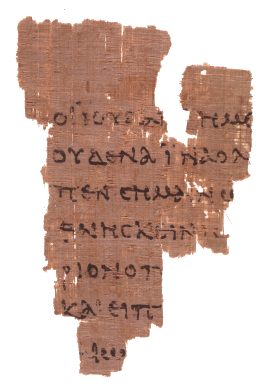
This small fragment of St. John's Gospel, less than nine centimetres high and containing on the one side part of verses 31-33, on the other of verses 37-38 of chapter xviii is one of the collection of Greek papyri in the John Rylands Library, Manchester. It was originally discovered in Egypt, and may come from the famous site of Oxyrhynchus (Behnesa), the ruined city in Upper Egypt where Grenfell and Hunt carried out some of the most startling and successful excavations in the history of archaeology; it may be remembered that among their finds of new fragments of Classical and Christian literature were the now familiar "Sayings of Jesus". The importance of this fragment is quite out of proportion to its size, since it may with some confidence be dated in the first half of the second century A.D., and thus ranks as the earliest known fragment of the New Testament in any language.It provides us with invaluable evidence of the spread of Christianity in areas distant from the land of its origin; it is particularly interesting to know that among the books read by the early Christians in Upper Egypt was St. John's Gospel, commonly regarded as one of the latest of the books of the New Testament. Like other early Christian works which have been found in Egypt, this Gospel was written in the form of a codex, i.e. book, not of a roll, the common vehicle for pagan literature of that time.
A larger view of the fragment: recto and verso.
© John Rylands University Library of Manchester.